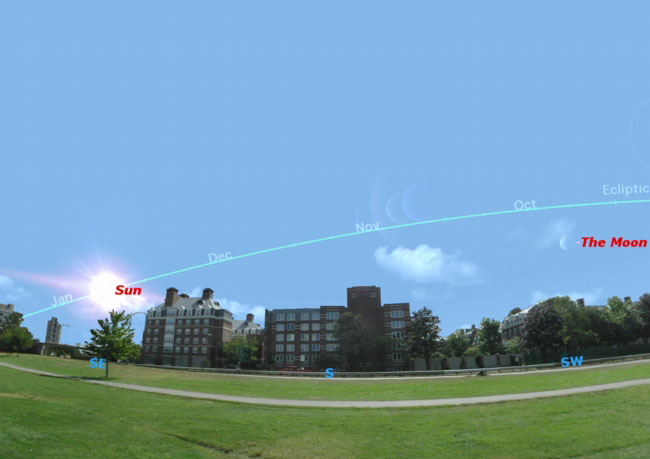Doorstep Astronomy: Where the Moon Hides

The moon will be at third quarter, sometimes called lastquarter, Thursday morning, but most people won?t see it.
The moon rises approximately 50 minutes later each nightthrough its monthly cycle around the Earth. At full moon, which was on newyear?s eve, the moon rose just around sunset. By tonight, a week later, it willbe rising in the southeast around midnight, after most people have gone to bed.By sunrise, it will have moved around to the south-southwest.
A couple of hours later, the sun will be well up in the skyin the southeast, and the moon will be in the southwest. The moon will beplainly visible, but most people never think to look for the moon in the daytimesky, even though it?s visible there at some point almost every day of themonth.
Most people nowadays believe incorrectly that the moon isonly visible at night. Many also believe that it is visible all night everynight, also incorrect. Because of the Earth?s rotation, the moon, like the sun,planets, and stars, appears to rise and set every day. Because it is in orbitaround the Earth, its rising and setting times change every day byapproximately 50 minutes.
For the next week, as the moon moves from third quarter tonew moon, it will continue to rise later in the night and spend more time inthe daytime sky. On the date of new moon, Jan. 15, the moon will be very closeto the sun in the sky, rising and setting together. In fact, they will be so closethat the moon will pass directly in front of the sun, causing an annular solareclipse visible over much of the Eastern Hemisphere.
A popular homework assignment is to ask students to keeptrack of the rising, setting, and position of the moon over a full lunar cycleof 29.5 days. Many students run into serious difficulties at this time of themonth because they can no longer see the moon at night. One of the purposes ofthis exercise is to get them to look for the moon during daytime, not just atnight.
When the moon is riding high in the southern sky aroundthird quarter, it?s an excellent time for students to see how the phases of themoon arise. Go out on a sunny morning when the moon is in the sky and hold aball up in the air. The sunlight falling on the ball will cause exactly thesame phase to appear on the ball as on the moon in the sky, because both areilluminated by the sun from the same angle.
Get the Space.com Newsletter
Breaking space news, the latest updates on rocket launches, skywatching events and more!
- More AboutThis: Where the Moon Hides
- More Night Sky Features from StarryNight Education
Thisarticle was provided to SPACE.com by Starry Night Education, theleader in space science curriculum solutions.
Join our Space Forums to keep talking space on the latest missions, night sky and more! And if you have a news tip, correction or comment, let us know at: community@space.com.

Geoff Gaherty was Space.com's Night Sky columnist and in partnership with Starry Night software and a dedicated amateur astronomer who sought to share the wonders of the night sky with the world. Based in Canada, Geoff studied mathematics and physics at McGill University and earned a Ph.D. in anthropology from the University of Toronto, all while pursuing a passion for the night sky and serving as an astronomy communicator. He credited a partial solar eclipse observed in 1946 (at age 5) and his 1957 sighting of the Comet Arend-Roland as a teenager for sparking his interest in amateur astronomy. In 2008, Geoff won the Chant Medal from the Royal Astronomical Society of Canada, an award given to a Canadian amateur astronomer in recognition of their lifetime achievements. Sadly, Geoff passed away July 7, 2016 due to complications from a kidney transplant, but his legacy continues at Starry Night.









